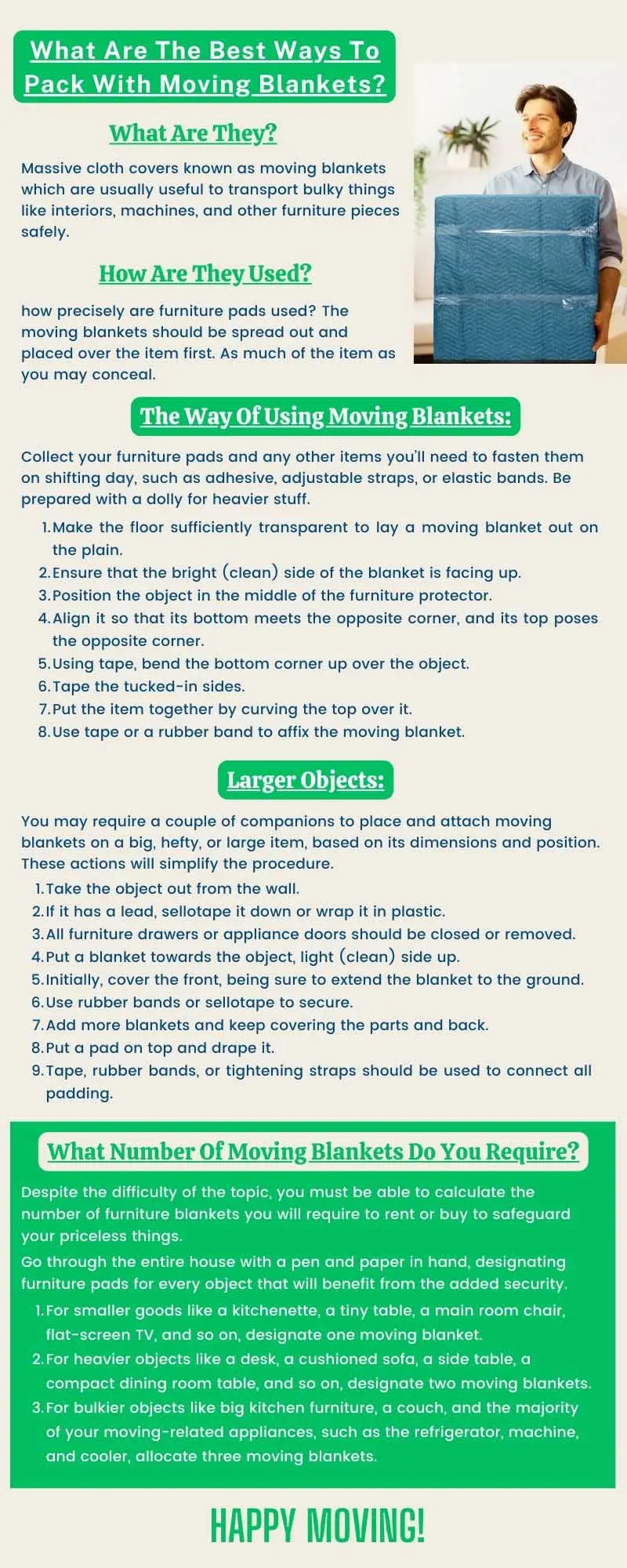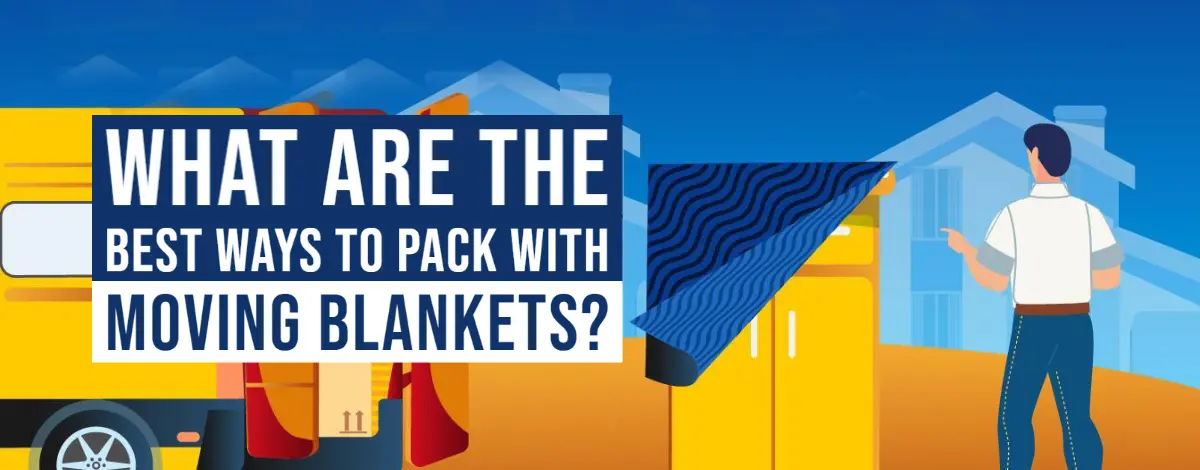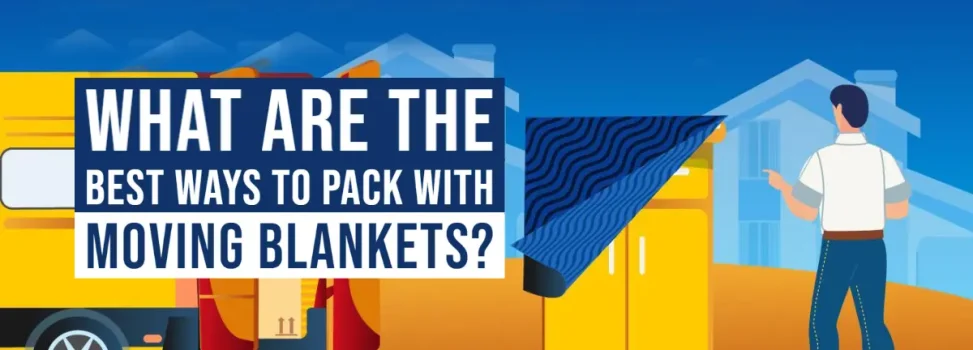Along with the essential packaging like cartons, wrapping paper, and bubble wrap, you will also require a lot of moving blankets if you do your packing. That is particularly crucial if you intend to move with several of your furnishings and/or home devices. Heavy moving blankets will support and shield devices, furnishings, and other possessions from harm (smudges, dings, scratches, cuts, etc.)—a process known as primary shielding.

Furthermore, you will provide a quite secondary shielding for your walls, floors, and doors by wrapping your bulky objects in moving blankets. It’s wise to stock up on moving blankets before relocating to guarantee that all of your belongings arrive at your new home undamaged.
Moving Blankets: What Are They?
Massive cloth covers known as moving blankets which are usually useful to transport bulky things like interiors, machines, and other furniture pieces safely. These blankets are essential to pad everything they are wrapping in stabilizing. Fabric, polyester, or a mix of the two are usually used as furniture cushioning. Also, several moving blankets have internal padding to give an added layer of security for delicate goods during transit.
Moving Blankets: How Are They Used?
To shift like a professional, you’ll require to prepare like an expert, which entails getting the necessary shifting equipment like moving blankets. But how precisely are furniture pads used? The moving blankets should be spread out and placed over the item first. As much of the item as you may conceal. If one moving blanket is insufficient to completely enclose the object, make sure to keep a spare one available. Firstly, the moving blanket needs to be fastened to the furnishings, devices, or other objects, secondly.
We advise securing the moving blanket to the object utilizing packaging tape or a layer of stretching wrap on the upper edge. Finally, begin transporting the object to the new house after it has been covered firmly with the moving blanket. We advise using a skid loader or slider when the thing is big to move it to and from the shifting vehicle. When you eventually get to your new house, you can take the furniture cushion off the object.
What Makes Moving Blankets A Good Idea?
A moving blanket is also known as furniture padding. It is strongly advised to use furniture coverings when moving home. The following are the primary benefits of utilizing furniture pads when shifting out, in case you’re starting to notice why you require moving blankets:
- During a relocation, moving blankets will shield your belongings from dings, scrapes, and other types of unanticipated losses. How? The pads will surround the delicate items you want to preserve with a strong patch of protection.
- On the journey to the new house, furniture blankets will cushion any blows, catastrophic events, or movement that are likely to happen. That reduces the possibility that the blankets you’ve wrapped around your equipment and furnishings will cause them any harm from jerks or movements.
- During the shifting process, moving blankets will maintain your personal belongings free of contaminants. And it’s always a plus, given how filthy shifting vehicles’ interiors can be.
- Furniture pads will also inadvertently help shield your floors and walls. It will not damage your hallway or surface if you have a piece of furniture or domestic appliances, you can cushion them inside or outside. Because of the padding’s substantial thickness, it will be in good condition.
The Way Of Using Moving Blankets:
Collect your furniture pads and any other items you’ll need to fasten them on shifting day, such as adhesive, adjustable straps, or elastic bands. Be prepared with a dolly for heavier stuff. The procedure of wrapping little objects differs differently from that of larger ones. To guarantee that tiny things are adequately secured, read the instructions.
- Make the floor sufficiently transparent to lay a moving blanket out on the plain.
- Ensure that the bright (clean) side of the blanket is facing up.
- Position the object in the middle of the furniture protector.
- Align it so that its bottom meets the opposite corner, and its top poses the opposite corner.
- Using tape, bend the bottom corner up over the object.
- Tape the tucked-in sides.
- Put the item together by curving the top over it.
- Use tape or a rubber band to affix the moving blanket.
Larger Objects:
You may require a couple of companions to place and attach moving blankets on a big, hefty, or large item, based on its dimensions and position. These actions will simplify the procedure.
- Take the object out from the wall.
- If it has a lead, sellotape it down or wrap it in plastic.
- All furniture drawers or appliance doors should be closed or removed.
- Put a blanket towards the object, light (clean) side up.
- Initially, cover the front, being sure to extend the blanket to the ground.
- Use rubber bands or sellotape to secure.
- Add more blankets and keep covering the parts and back.
- Put a pad on top and drape it.
- Tape, rubber bands, or tightening straps should be used to connect all padding.
Cover Appliances With Moving Blankets:
Use the methods listed above to wrap household items in secure blankets because the process is the same as wrapping furniture for a relocation. To prevent a tripping hazard, ensure that the power line is securely fastened before wrapping an appliance in furniture padding.
It’s a good idea to take your furniture and appliances from the house so you can place them onto the shifting truck after you’ve covered them in furniture padding. Utilize a furnishing slider or an item mover to move them out securely when some of them appear to be too large to manage.
Make Use Of Moving Blankets To Shield Door Frames, Walls, And Doors:
By encircling your furniture and appliances in moving blankets, you can indirectly safeguard your walls, floors, and doors. Nonetheless, you can bind a couple of blankets to those exposed wall portions anyway in case when you’re concerned about the chance of damaging the walls, such as a blind curve, for instance.
Additionally, place a large moving blanket over the top portion of a door and attach it to the door frame with the artist’s tape to prevent doors and door frames from unintentionally having damaged, slashed, cracked, scrubbed, or lost. If additional coverage is essential, fasten an additional blanket to the previous one to completely enclose the door.
What Number Of Moving Blankets Do You Require?
Despite the difficulty of the topic, you must be able to calculate the number of furniture blankets you will require to rent or buy to safeguard your priceless things.
Go through the entire house with a pen and paper in hand, designating furniture pads for every object that will benefit from the added security.
- For smaller goods like a kitchenette, a tiny table, a main room chair, flat-screen TV, and so on, designate one moving blanket.
- For heavier objects like a desk, a cushioned sofa, a side table, a compact dining room table, and so on, designate two moving blankets.
- For bulkier objects like big kitchen furniture, a couch, and the majority of your moving-related appliances, such as the refrigerator, machine, and cooler, allocate three moving blankets.
Purchase Or Rent Moving Blankets?
In general, there are two options for obtaining moving blankets: renting them or buying them. As opposed to free moving boxes, free furniture paddings are more difficult to come by merely because they are more costly, and you can handle them so many times until they are completely unusable.
To put it another way, people won’t be willing to give away their furniture padding until they are completely shredded, at which point, no matter how free they are, you won’t be able to use them.
Furniture Padding For Rent:
When you’ve decided to wrap your goods yourself or simply rent a shifting vehicle and transfer them without employing removalists to carry out the task for you, renting furniture paddings will typically be your best choice.
After buying heavy-duty moving blankets for wrapping purposes, you will require to locate space to keep them once the movement is through. Also, buying those cushioned furniture paddings can quickly turn out to be a negative idea if you don’t have any immediate plans to shift again because you’ll be compelled to store them for a very long time without understanding if you’ll ever need them anymore.
Purchase A New Moving Blanket:
In some circumstances, buying furniture pads can be preferable, and renting them out until the job is finished. For instance, if you’re temporarily shifting, and you understand that the next relocation will be required in the following months, then making the effort to buy those furniture coverings should be worthwhile since you can utilize them when the time is appropriate.
Consider using a competent moving company instead of renting or purchasing moving blankets if it feels like too much labor. Moving blankets are typically included in the price of hiring professional movers and packers, who will also handle the entire process for you. To locate the best experts for the job, search through the vast network of reputable, insured, and licensed movers on the 1Support digital platform.
FAQ
To effectively secure objects without slipping or ripping packaging tape, a moving blanket must be strong enough. Heavy-duty blankets can be almost an inch strong, while featherweight blankets may be as light as 0.125 inches.
Although they are frequently designed water-resistant products, they are not usually waterproof. Seek for moving blankets with “poly” on the label, such as polyester or polypropylene, when you need something that won’t get wet.
Whereas we advise against washing moving blankets since they are easily torn or ruined, we nonetheless advise that you do something to enhance their appearance and odor.


